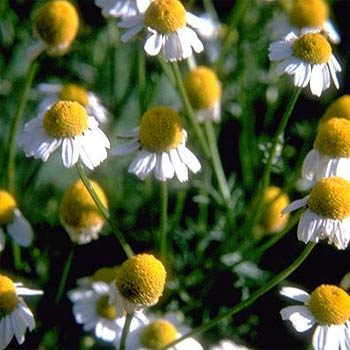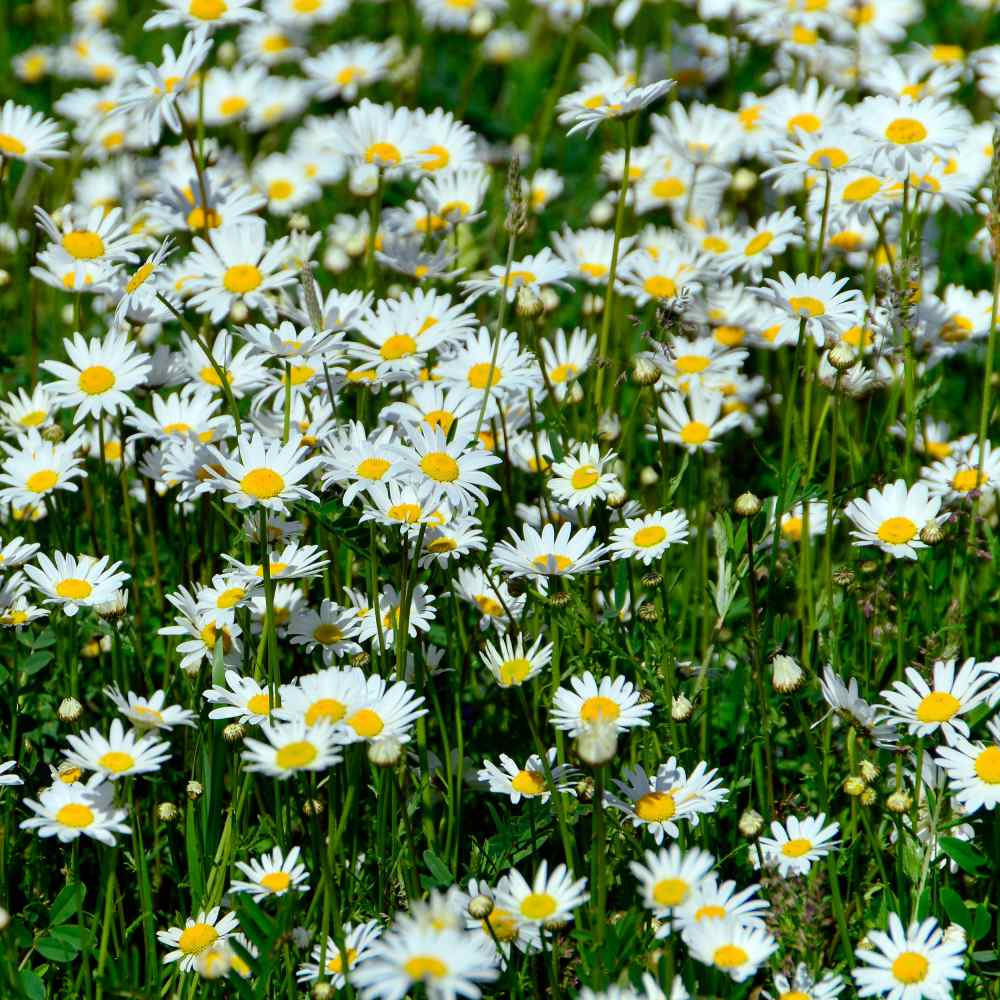New Account | Seed Mix |
Gift Certificates |AAS Winners |
Gardening Products
SEEDS: Unusual | Annuals | Perennials | Vegetables | Herbs | Trees
Roman and German Chamomile Seeds
Useful gardening information
Season: AnnualUSDA Zones: 4 - 8
Height: 18 - 24 inches
Bloom Season: Summer
Bloom Color: White
Environment: Full sun
Soil Type: Moist, well-drained, pH 6.1 - 7.5
Planting Directions
Temperature: 65 - 80F
Average Germ Time: 10 - 14 days
Light Required: Yes
Depth: Press into soil but do not cover
Sowing Rate: 1 seed per inch
Moisture: Keep moist until germination
Plant Spacing: Rows 18 inches a part; thin seedlings 10 inches
How to grow, use and identify chamomile

W206 German Chamomile ( Matricaria recutita )
An easy to grow annual with pretty daisy like flowers, the flowers are scented, and only the flowers are used for making tea.
If you want to harvest flowers for making Chamomile tea, it is best to collect flowers on a sunny day (ensuring that the flowers are fully open), then dry them in the sun. Discard the stems and leaves and store the chamomile flowers in an air tight container.
German Chamomile is most often used for medicinal purposes, and is usually administered as a tea. It can also be administered as a compress for external healing and as a bath for babies. Here are a few uses:
Soothes and relaxes at bedtime.
Relieves restlessness, teething problems, and colic in children.
Relieves allergies, much as an antihistamine would.
Aids digestion when taken as a tea after meals.
Relieves morning sickness during pregnancy.
Speeds healing of skin ulcers, wounds, or burns.
Treats gastritis and ulcerative colitis.
Other Uses
Makes a relaxing bath or footbath.
Lightens fair hair and conditions complexion. Make a rinse by simmering 2 teaspoons dried flowers in 8 ounces of water for 15 minutes.
Potpourri (dry flowers face down.)
Parts of plant to use for tea: Flowers only. Taste: A rather pleasant taste, made very nice with a little bit of honey.
If you want to harvest flowers for making Chamomile tea, it is best to collect flowers on a sunny day (ensuring that the flowers are fully open), then dry them in the sun. Discard the stems and leaves and store the chamomile flowers in an air tight container.
German Chamomile is most often used for medicinal purposes, and is usually administered as a tea. It can also be administered as a compress for external healing and as a bath for babies. Here are a few uses:
Soothes and relaxes at bedtime.
Relieves restlessness, teething problems, and colic in children.
Relieves allergies, much as an antihistamine would.
Aids digestion when taken as a tea after meals.
Relieves morning sickness during pregnancy.
Speeds healing of skin ulcers, wounds, or burns.
Treats gastritis and ulcerative colitis.
Other Uses
Makes a relaxing bath or footbath.
Lightens fair hair and conditions complexion. Make a rinse by simmering 2 teaspoons dried flowers in 8 ounces of water for 15 minutes.
Potpourri (dry flowers face down.)
Parts of plant to use for tea: Flowers only. Taste: A rather pleasant taste, made very nice with a little bit of honey.

SF084 Roman Chamomile ( Chamaemelum nobile )
Roman Chamomile seeds produce a thick, evergreen perennial herb plant that is very versatile and lovely. Forms a 6 inch mat of sweetly scented, parsley-like, bright green foliage, and it produces tiny, white and yellow daisy-like blooms in the late spring. An herbal flowering carpet comes to life!
This herbal carpet can even be used as a lawn substitute. This species is grown for the famous British Chamomile lawns.
Roman Chamomile plants may deteriorate in very cold or wet winters, but they will most likely recover. Harvest chamomile flowers when they are first fully opened. Use them fresh or freeze them for later use. Another benefit is that the flowers are used in herbal teas and are said to have medicinal properties.
Often used as a ground cover, Roman Chamomile holds soil in place even on slopes, it spreads to fill in gaps, and it blocks out most weeds. It can be mowed (after flowering and set the mower on the highest setting), and it tolerates light foot traffic. This ground cover is unique, aromatic, attractive and is well-suited for covering large areas and can be started by sowing the herb seeds ( Sow on cultivated soil. Sowing Rate: Approximately 5,000 seeds covers 100 square feet. Average Germ Time: 7 - 10 days. Keep moist until germination. Depth: Surface sow, cover lightly with peat moss. )
Attracts honeybees and birds. Young leaves and flowers can be gathered to make a calming tea, both fresh and dried.
Grows well in zones 4-9.
This herbal carpet can even be used as a lawn substitute. This species is grown for the famous British Chamomile lawns.
Roman Chamomile plants may deteriorate in very cold or wet winters, but they will most likely recover. Harvest chamomile flowers when they are first fully opened. Use them fresh or freeze them for later use. Another benefit is that the flowers are used in herbal teas and are said to have medicinal properties.
Often used as a ground cover, Roman Chamomile holds soil in place even on slopes, it spreads to fill in gaps, and it blocks out most weeds. It can be mowed (after flowering and set the mower on the highest setting), and it tolerates light foot traffic. This ground cover is unique, aromatic, attractive and is well-suited for covering large areas and can be started by sowing the herb seeds ( Sow on cultivated soil. Sowing Rate: Approximately 5,000 seeds covers 100 square feet. Average Germ Time: 7 - 10 days. Keep moist until germination. Depth: Surface sow, cover lightly with peat moss. )
Attracts honeybees and birds. Young leaves and flowers can be gathered to make a calming tea, both fresh and dried.
Grows well in zones 4-9.
Share a growing tip or recipe and help other gardeners!
Click on the Contact Form link, place "Tip" in the name line and fill in your information. If we accept your Chamomile growing tip or recipe, we will post it on this page.
